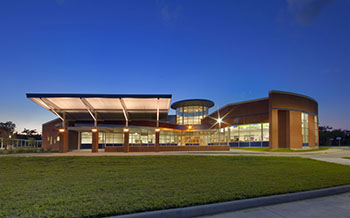Louisiana School Wins National Energy Efficiency Competition
 BATON ROUGE, La. — Upgrades to facility controls and the energy management system (EMS) at Claiborne Elementary in Baton Rouge helped the school win the Energy Star National Building Competition, Battle of the Buildings.
BATON ROUGE, La. — Upgrades to facility controls and the energy management system (EMS) at Claiborne Elementary in Baton Rouge helped the school win the Energy Star National Building Competition, Battle of the Buildings.
Claiborne was one of more than 3,000 buildings nationwide that spent the past year trying to obtain the greatest reduction in energy use and win the EPA-sponsored competition. The school demonstrated a 46 percent reduction in energy use on its campus, and annual energy operating costs fell from $2.07 per square foot in 2012 to $1.32 per square foot in 2013.
When the 100,892-square-foot school replaced a much smaller 60-year-old facility, one of the biggest challenges for the school district was to keep up with higher operation and energy costs. These costs were the result of modern requirements for integrated technologies, lighting, ventilation, humidity control and other construction codes. During the first year it operated, the new school’s energy costs were $2.07 per square foot compare to the $1.59 average for the old school during its final four years of operation.
Philadelphia-based Aramark, the energy management partner to the East Baton Rouge Parish School System (EBRPSS), works closely with Louisiana Controls, one of the school district’s three facility controls and EMS partners, to support more than a dozen systems Louisiana Controls has installed for the school district.
Louisiana Controls Inc. (LCI) implemented the EMS specified for the new Claiborne School, which included HVAC equipment controls and energy management functions. During the post-construction warranty period, which was the first year of occupancy, Aramark energy managers worked with the school’s principal and administration staff to schedule and operate the facility as efficiently as possible, while maintaining required comfort conditions.
“Once the warranty period expired, Aramark energy managers collaborated with Louisiana Controls to develop and implement specific modifications and refinements to the facility control sequences and energy management functions,” said Tommy Reed, president and general manager of Louisiana Controls, in a statement. “Some of these included changes to ventilation control strategies to more closely match delivered fresh air ventilation volumes to the actual needs of occupied spaces, as well as the addition of discharge air temperature reset control during periods of normal humidity levels.”
Some of the specific changes from LCI included adding “Supply Air Set Point Reset off of Return Air Temp for all variable-air air handling units (AHUs),” and programming “the adjustable functionality to shut the central plant down prior to the AHUs shutting down off of schedule,” said Keith Hobbs, a spokesman for LCI in an email.
“InsideIQ members like Louisiana Controls are experts at helping facility operators, like school districts, to achieve greater energy efficiency,” said Frank Rotello, president of the InsideIQ Building Automation Alliance. “In this case, taking advantage of the EMS’s capability to analyze, trend and quantify control functions and system operation contributed to energy savings, as did the technical expertise of Louisiana Controls to effectively implement the original construction specifications. Additional modifications and refinements to the EMS, such as adding demand-controlled ventilation and discharge air temperature reset, further improved efficiency.”
